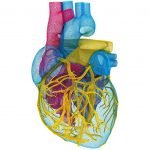Estrogen Dominance in Men
Tolle Totum
Serena Goldstein, ND
We are now in a day and age where many of our concerns, such as heart disease, obesity, cancer, and autoimmune conditions, are due to a variety of causes and therefore require a variety of therapies. This is in contrast to around 100 years ago, when cure usually meant 1 treatment for 1 disease. A few decades into the 1900s, pesticides, hormones, and antibiotics were introduced into food. Several decades later, we now live more sedentary, stressed-out lifestyles that are contributing to a myriad of health concerns, including estrogen dominance. Over the past 30 years, testosterone levels in men have been declining.1 This is most likely due to the rise in obesity over the past few decades,2,3 since fat cells contain aromatase, an enzyme that converts testosterone to estrogen, and estrogen levels are positively correlated with body fat mass.4
A Brief Review of Hormone Physiology
Men naturally have both estrogens and androgens; however, for optimal function, they must stay in proper balance. Estrogen in men contributes to the growth and maturity of sperm, libido, bone health, cardiovascular health, and prostate health.5 After the age of 30, testosterone levels slowly decline, partly due to increased aromatase activity and partly due to the fact that estrogen also binds to androgen receptors. This binding inhibits gonadotropin-releasing hormone (GnRH), which would otherwise tell the body to make more testosterone by increasing production of luteinizing hormone (LH) in the testes.
Estrogen is made in the adrenal glands, fat cells (adipose tissue), and testes. There are 2 receptors for estrogen – alpha and beta – with alpha exerting stronger estrogenic effects than beta. Alpha receptors are found in the prostate (stroma), testes (Leydig cells), epididymis, bone, brain, liver, and white adipose tissue, whereas beta receptors are expressed in the colon, prostate (epithelium), testes, bone marrow, salivary gland, vascular epithelial, and brain.6
Estrogen metabolites, such as 2-hydroxy (OH), 4-OH, and 16α-OH, derive from the parent hormones, estradiol and estrone. These 2 estrogens can convert back and forth into each other via hepatic hydroxylases, and are then prepared for elimination from the body by being metabolized through glucuronidation, sulfation, and/or methylation. The enzyme responsible for methylation – catechol-O-methyltransferase (COMT) – converts 2-OH-estrogen to 2-methoxy-estrogen, which is a protective form of estrogen. The metabolites 4-OH and 16α-OH are generally not regarded as favorable estrogens, especially in terms of cancer risk. Estrogen is bound to carrier proteins such as sex hormone-binding globulin (SHBG) and, to a lesser extent, albumin. Bound hormone is not active.
Sources of Additional Estrogens
Although the body employs quite a number of dedicated processes to keeping estrogens in balance, via production and metabolism, exogenous estrogens have become extremely prevalent in our society, especially through diet and environment. Significant dietary sources include estrogens added to meats and dairy.7 Xenoestrogens, which bind to estrogen alpha receptors, are non-physiological compounds that can also evoke estrogen responses. They are present in diethylstilbestrol (DES), coumestrol (a phytoestrogen), bisphenol A (BPA), dichlorodiphenylethylene (DDE, a metabolite of DDT), nonylphenol, endosulfan, and dieldrin. They can interfere with endogenous estrogen actions and may also cause increased prolactin secretion.8 These endocrine disruptors are prevalent in skin, cleaning, and beauty products; plastic food containers; orthodontia materials9 (eg, clear aligners, retainers, adhesives), pollution; pesticides; and artificial preservatives. Research suggests that these environmental estrogens may be contributing to increased risks in men of testicular cancer, cryptorchidism, hypospadia, and decreased semen quality.10
Hormone Interrelationships
Hormones are pulsatile, but are nicely regulated in the body. Although not extensively researched, progesterone may have a role in balancing estrogen dominance in men. Progesterone, which derives mostly from the adrenals in men,11 is a precursor to both estrogens and androgens, and has an influence on testosterone production, sperm function, and several other functions in the body.12 Estrogen (and possibly xenoestrogens) may be a driving force in prostate cancer, and progesterone has been proposed as a possible protective factor.13,14
Elevated estrogen can also contribute to obesity by increasing the concentration of thyroid-binding globulin (TBG), which binds thyroid hormone. Lower thyroid activity slows metabolism, leading to weight gain. Because aromatase in fat cells turns testosterone into estrogen, an increase in adipose exacerbates the problem.
Melatonin, our sleep hormone, can help counteract estrogen’s actions. However, a stressful lifestyle, bright lights at night (including electronic devices), and dietary factors such as alcohol, sugar, and caffeine15 can decrease our melatonin production and therefore its protective effects. Melatonin has been found in animals to modulate steroid synthesis in Leydig cells (eg, increase testosterone production and inhibit aromatase activity), and may have similar effects in humans.16
COMT, the enzyme that converts estrogen into 2-methoxy-estrogen, is also responsible for degrading dopamine, norepinephrine, and epinephrine. Since COMT mutations may contribute to higher serum estradiol levels due to a less efficient degradation of estrogens, and because of its role in degrading catecholamines, variations in COMT may predispose individuals toward high estrogen and anxiety.17 Needless to say, someone who’s constantly anxious is not going to be sleeping well. Sleep also regulates the hormones related to satiety, so poor sleep can place people at risk of eating unhealthier foods, which can lead to weight gain and even insulin resistance – another factor possibly linked to elevated estrogen in men.18
Hormone Testing
Hormone testing can be performed using serum, saliva, or urine, each with its own characteristics. Blood is convenient in that it can also be used for other basic blood work (eg, CBC, CMP, vitamin D) that provides additional information about the patient’s health that can affect hormone imbalance, such as blood sugar or thyroid issues. However, a blood test for hormones is only a snapshot in time. It also often only reflects total sex hormone levels, which don’t differentiate between bound hormone and free (unbound) hormone. This means that hormone levels may appear normal despite the patient being symptomatic. Measuring “free” fractions of hormone and/or adding SHBG and cortisol-binding globulin (CBG; transcortin) can provide a more accurate picture.
Saliva and urine are great non-invasive tests that measure the unbound hormones, and the latter goes a step further to reflect hormone metabolites, as well as cortisol and melatonin. Salivary testing provides a more accurate read of the pulsatile nature of hormones relative to our diurnal rhythm. Salivary and urinary options can be limited to the amount of saliva made by the patient, or by significant liver or kidney disease; urine testing is also limited by dehydration or excessive fluid intake.19 Genetic tests for MTHFR, COMT, SULT, and CYP can offer a more in-depth picture and understanding of various hormone metabolites.
Therapeutic Approach
The rise of estrogen dominance in men is likely strongly influenced by the presence of chemicals in foods and the environment that mimic the effects of estrogen. Encourage patients to strip their cabinets of potential chemical-laden products and to replace them with more natural and organic options. Also encourage them to reduce foods that contain estrogen or raise estrogen activity and to focus instead on the consumption of dark leafy greens and cruciferous vegetables that will help reduce estrogen and promote more optimal metabolites. Due to their selenium content (also a great nutrient for thyroid), indole-3-carbinol (helps promote production of the 2-OH metabolite), glucosinolate hydrolysis, and sulforaphane (binds, then inactivates estrogen), cruciferous vegetables are highly protective against cancer, possibly more than the total intake of fruits and vegetables.20 Furthermore, crucifers’ high vitamin and mineral content promotes competent phase I and phase II liver detox pathways that ensure the safe excretion of compounds.
Cholesterol is the building block of sex hormones, so healthy, cholesterol-rich foods should be encouraged. Vitamin and mineral-rich foods such as avocados can help support liver detox pathways including methylation; high-fiber foods can also help regulate bowel movements. Ground flax seeds (have weak estrogen content, promote healthy gut bacteria, and bind estrogen in the liver), nuts, wild-caught fish, and olive oil all help optimize production (they provide nutrients for detox pathways and testosterone production, and promote healthy cell membrane function), as well as provide satiety and help balance blood sugar.
Recommend intake of high-fiber foods, such as vegetables, ground flax or chia seed, apples, legumes, and berries, in amounts of 25-30 grams per day for healthy bowel movements, since constipation allows toxins and hormones to recirculate in the body. Have patients aim for water intake that equals at least half their body weight in ounces. Encourage a regular bedtime, ideally before 11 PM, in order to optimize melatonin production, as most of it is produced between 11 PM and 3 AM.
Resistance training is an effective way to boost testosterone,21 reduce body fat, increase basal metabolic rate, and improve insulin sensitivity.22 Consider mixing it up with more vigorous-intensity exercise (eg, high-intensity interval training) to further reduce the effects of insulin resistance and promote weight loss.23
Supplements
Supplements to focus on for balancing hormones include those that act on hormone production and metabolism and which support hepatic health, as the liver is such an important organ in hormone health. Some specific supplements to consider include calcium-D-glucarate (inhibits bacterial beta-glucuronidase in the gut,24 which would otherwise cleave estrogen from a bound molecule, allowing it to recirculate), saw palmetto (decreases 5α-reductase),25 grapeseed extract (decreases aromatase26), and Vitex agnus castus (boosts progesterone). Support the liver with bitter herbs, as well as quercetin, alpha-lipoic acid, and N-acetylcysteine. Optimize 25-OH-vitamin D levels to around 40-50 ng/mL, and perhaps higher in patients with cancer or autoimmune conditions.
It’s important to keep the big picture in mind when supplementing, as there may be other concerns, eg, sleep problems or mood issues, which could also be contributing to hormone imbalances and present themselves as obstacles to cure in balancing hormones.
Conclusion
In my practice, I’ve seen many men younger than 40 years of age with a testosterone level lower than that of men over the age of 40 or even 50. This likely reflects differing exposures in each generation. Our environment today is very different from our environment decades ago, which may necessitate greater attention to a health maintenance routine that can enable us to achieve health goals as well as live a long, quality life. Fortunately, many of the nutritional and lifestyle therapies described above help to balance hormones, while also helping to prevent a future recurrence of estrogen dominance as well as many other lifestyle-based diseases.
Refs:
- Travison TG, Araujo AB, O’Donnell AB, et al. A population-level decline in serum testosterone levels in American men. J Endocrinol Metab. 2007;92(1):196-202.
- Ogden CL, Carroll MD. Prevalence of Overweight, Obesity, and Extreme Obesity Among Adults: United States, Trends 1960–1962 Through 2007–2008. June 2010. Centers for Disease Control and Prevention. Available at: https://www.cdc.gov/nchs/data/hestat/obesity_adult_07_08/obesity_adult_07_08.pdf. Accessed July 20, 2018.
- Hales CM, Carroll MD, Fryar CD, Ogden CL. Prevalence of Obesity Among Adults and Youth: United States, 2015–2016. October 2017. Centers for Disease Control and Prevention. NCHS Data Brief, No. 288. Available at: https://www.cdc.gov/nchs/data/databriefs/db288.pdf. Accessed July 20, 2018.
- Vermeulen A, Kaufman JM, Goemaere S, van Pottelberg I. Estradiol in elderly men. Aging Male. 2002;5(2):98-102.
- Carreau S, de Vienne C, Galeraud-Denis I. Aromatase and estrogens in man reproduction: a review and latest advances. Adv Med Sci. 2008;53(2):139-144.
- Dahlman-Wright K, Cavailles V, Fuqua SA, et al. International Union of Pharmacology. LXIV. Estrogen receptors. Pharmacol Rev. 2006;58(4):773-781.
- Greger M. Estrogen in Animal Products. September 13, 2016. NutritionFacts.org. Available at: https://nutritionfacts.org/2016/09/13/estrogen-animal-products/. Accessed July 21, 2018.
- Watson C, Bulayeva N, Wozniak A, Alyea R. Xenoestrogens are potent activators of nongenomic estrogenic responses. Steroids. 2007;72(2):124-134.
- Kotyk MW, Wiltshire WA. An investigation into bisphenol-A leaching from orthodontic materials. Angle Orthod. 2014;84(3):516-520.
- Jensen TK, Toppari J, Keiding N, Skakkebaek NE. Do environmental estrogens contribute to the decline in male reproductive health? Clin Chem. 1995;41(12):1896-1901.
- Wirth MM, Meier EA, Fredrickson BL, Schultheiss OC. Relationship between salivary cortisol and progesterone levels in humans. Biol Psychol. 2007;74(1):104-107.
- Oettel M, Mukhopadhyay AK. Progesterone: the forgotten hormone in men? Aging Male. 2004;7(3):236-257.
- Lee JR. Hormone Balance for Men: What Your Doctor May Not Tell You About Prostate Health and Natural Hormone Supplementation. One to One Inc; 2012.
- Lieberman A, Curtis L. In Defense of Progesterone: A Review of the Literature. Altern Ther Health Med. 2017;23(6):24-32.
- Peuhkuri K, Sihvola N, Korpela R. Dietary factors and fluctuating levels of melatonin. Food Nutr Res. 2012;56. doi: 10.3402/fnr.v56i0.17252.
- Yu K, Deng SL, Sun TC, et al. Melatonin Regulates the Synthesis of Steroid Hormones on Male Reproduction: A Review. Molecules. 2018;23(447). Available at: http://www.mdpi.com/1420-3049/23/2/447. Accessed July 21, 2018.
- Eriksson AL, Skrtic S, Niklason A, et al. Association between the low activity genotype of catechol-O-methyltransferase and myocardial infarction in a hypertensive population. Eur Heart J. 2004;25(5):386-391.
- Williams G. Aromatase up-regulation, insulin and raised intracellular oestrogens in men, induce adiposity, metabolic syndrome and prostate disease, via aberrant ER-α and GPER signalling. Mol Cell Endocrinol. 2012;351(2):269-278.
- Larsen P, Kaplan M, Alvarado L, Lee MJ. Hormone Testing: When to Use Serum, Saliva, and Urine. January 2014. The Townsend Letter. http://www.townsendletter.com/Jan2014/hormone0114.html. Accessed August 11, 2018.
- Keck AS, Finley JW. Cruciferous vegetables: cancer protective mechanisms of glucosinolate hydrolysis products and selenium. Integr Cancer Ther. 2004;3(1):5-12.
- Vingren JL, Kraemer WJ, Ratamess NA, et al. Testosterone physiology in resistance exercise and training: the up-stream regulatory elements. Sports Med. 2010;40(12):1037-1053.
- Kraemer WJ, Ratamess NA, French DN. Resistance training for health and performance. Curr Sports Med Rep. 2002;1(3):165-171.
- Keshel TE, Coker RH. Exercise Training and Insulin Resistance: A Current Review. J Obes Weight Loss Ther. 2015;5(Suppl 5). pii: S5-003.
- [No authors listed]. Calcium-D-glucarate. Altern Med Rev. 2002;7(4):336-339.
- Habib FK, Ross M, Ho CK, et al. Serenoa repens (Permixon) inhibits the 5alpha-reductase activity of human prostate cancer cell lines without interfering with PSA expression. Int J Cancer. 2005;114(2):190-194.
- Kijima I, Phung S, Hur G, et al. Grape seed extract is an aromatase inhibitor and a suppressor of aromatase expression. Cancer Res. 2006;66(11):5960-5967.
 Serena Goldstein, ND, is a naturopathic doctor in New York City who specializes in hormonal concerns such as weight, mood, stress, PMS, peri/menopause, and andropause. Dr Serena has been published in well-known health and wellness resources, such as MindBodyGreen, Consumer Health Digest, and the Hearty Soul. She has appeared on Sirius XM NYU Doctor Radio, and has lectured at Lehman College and the American Cancer Society. Dr Serena is also on the Advisory Board for Natural Practitioner Magazine and lends her expertise to fellow doctors at NYU-Hospital Poison Control Center. Contact Dr Serena at: www.drserenagoldstein.com.
Serena Goldstein, ND, is a naturopathic doctor in New York City who specializes in hormonal concerns such as weight, mood, stress, PMS, peri/menopause, and andropause. Dr Serena has been published in well-known health and wellness resources, such as MindBodyGreen, Consumer Health Digest, and the Hearty Soul. She has appeared on Sirius XM NYU Doctor Radio, and has lectured at Lehman College and the American Cancer Society. Dr Serena is also on the Advisory Board for Natural Practitioner Magazine and lends her expertise to fellow doctors at NYU-Hospital Poison Control Center. Contact Dr Serena at: www.drserenagoldstein.com.










